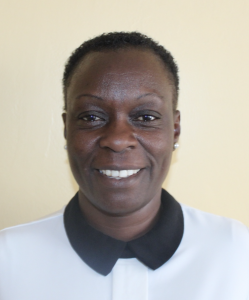Shihome is in a rural and peaceful area that is highly vegetated due to community members' farming. People primarily grow sugarcane, bananas, sweet potatoes, yams, and beans to support their families. Many young men in this area have decided to buy motorbikes and use them for taxiing, known as the boda boda business, and this has helped them to earn something to support their families.
The 280 people in Shihome who rely on Peter Majoni Spring for water come to the spring very early in the morning. This is preferred to the late morning and afternoon, when there are large crowds at the spring which increase both wait time and the muddiness of the water from having to step into it when fetching it. "People step in the water and make it dirty, so we don't take safe water for our health," said primary aged student Moses. The crowds are of particular concern during the pandemic, when community members are trying to limit their contact with groups and reduce the amount of time they have to spend in public.
When it rains, it is even harder to access the spring because the area is slippery and steep. The rains also pour more dirty surface runoff into the spring water, further contaminating it.
"Many years we have been taking dirty water. The water is contaminated and we use a lot of money for medication," said 68-year-old farmer Aron Kwemba. Diarrhea and typhoid are the most common water-related illnesses among community members, especially for children. Families are forced to spend money on medication for their water-related illnesses, draining their resources that could be better spent on other needs. Kids also miss a lot of classtime due to staying at home and seeking treatment for their waterborne illnesses.
What We Can Do:
Spring Protection
Protecting the spring will help provide access to cleaner and safer water and reduce the time people have to spend to fetch it. Construction will keep surface runoff and other contaminants out of the water. With the community’s high involvement in the process, there should be a good sense of responsibility and ownership for the new clean water source.
Fetching water is a task predominantly carried out by women and young girls. Protecting the spring and offering training and support will, therefore, help empower the female members of the community by freeing up more of their time and energy to engage and invest in income-generating activities and their education.
Training on Health, Hygiene, COVID-19, and More
To hold trainings during the pandemic, we work closely with both community leaders and the local government to approve small groups to attend training. We ask community leaders to invite a select yet representative group of people to attend training who will then act as ambassadors to the rest of the community to share what they learn. We also communicate our expectations of physical distancing and wearing masks for all who choose to attend.
The training will focus on improved hygiene, health, and sanitation habits in this community. We will also have a dedicated session on COVID-19 symptoms, transmission routes, and prevention best practices.
With the community’s input, we will identify key leverage points where they can alter their practices at the personal, household, and community levels to affect change. This training will help to ensure participants have the knowledge they need about healthy practices and their importance to make the most of their water point as soon as water is flowing.
Our team of facilitators will use a variety of methods to train community members. Some of these methods include participatory hygiene and sanitation transformation, asset-based community development, group discussions, handouts, and demonstrations at the spring.
One of the most important issues we plan to cover is the handling, storage, and treatment of water. Having a clean water source will be extremely helpful, but it is useless if water gets contaminated by the time it is consumed. We and the community strongly believe that all of these components will work together to improve living standards here, which will help to unlock the potential for these community members to live better, healthier lives.
We will then conduct a small series of follow-up trainings before transitioning to our regularly scheduled support visits throughout the year.
Training will result in the formation of a water user committee, elected by their peers, that will oversee the operations and maintenance of the spring. The committee will enforce proper behavior around the spring and delegate tasks that will help preserve the site, such as building a fence and digging proper drainage channels. The fence will keep out destructive animals and unwanted waste, and the drainage will keep the area’s mosquito population at a minimum.
Sanitation Platforms
At the end of training, participants will select 5 families that should benefit from new concrete latrine floors called sanitation platforms. Training will inform the community and selected families on what they need to contribute to make this project a success. They must mobilize locally available materials, including bricks, clean sand, and gravel. The 5 families chosen for sanitation platforms must prepare by sinking a pit for the sanitation platforms to be placed over.
All community members must work together to make sure that accommodations and food are always provided for the work teams. The families will then be asked to complete their latrines by constructing a superstructure over their platforms. These 5 sanitation platforms will then serve as examples for the rest of the community to replicate.



 Rehabilitation Project
Rehabilitation Project













































